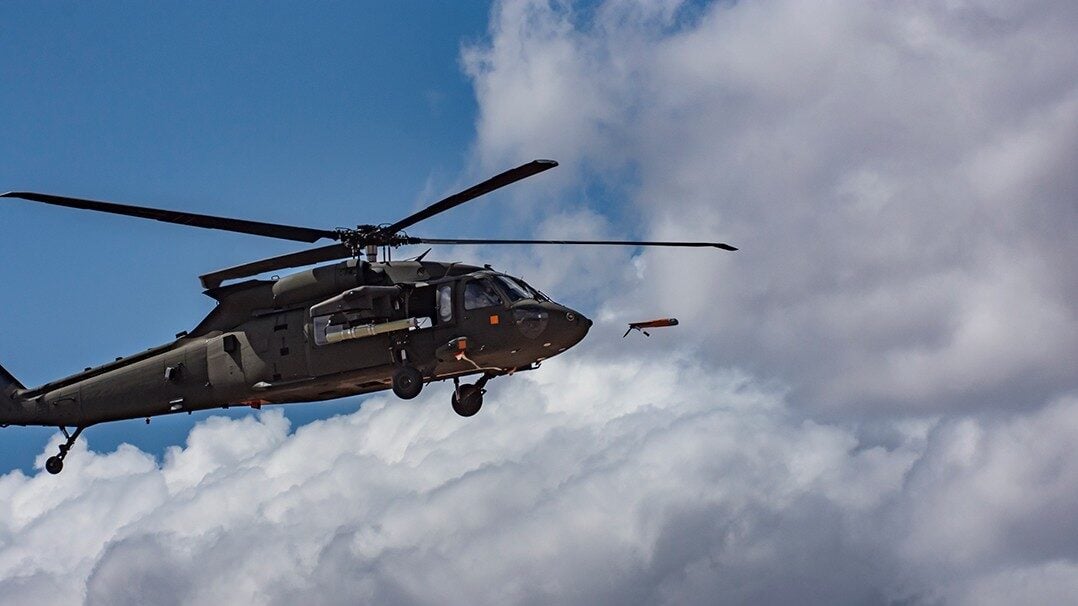
A UH-60 Black Hawk launches an ALTIUS mini-drone (aka ALE, or Air-Launched Effects). (Yuma Proving Ground photo)
WASHINGTON — To mark a full year since Russia’s invasion of Ukraine, the US today announced another $2 billion in weapons for Kyiv, including three types of drones that are not publicly known to have been sent before.
The package, which also includes ammunition for the High Mobility Artillery Rocket System (HIMARS), laser-guided rocket systems and 155mm artillery rounds, is being provided under the Ukraine Security Assistance Initiative, meaning the US is buying the equipment direct from the manufacturer instead of pulling from Defense Department stocks.
“Today’s solemn anniversary is an opportunity for all who believe in freedom, rules, and sovereignty to recommit ourselves to supporting Ukraine’s brave defenders for the long haul — and to recall that the stakes of Russia’s war stretch far beyond Ukraine,” US Secretary of Defense Lloyd Austin said in a statement.
Notably, the list of equipment includes three drone systems not listed on previous Ukraine assistance packages:
CyberLux K8 UAS: North Carolina-based CyberLux is a provider of small quadcopter unmanned systems. A business presentation from June 2022 lists US Special Operations Command, Air Mobility Command and the Army, Air Force and Marine Corps broadly as customers.
While the K8 design is not listed on the company’s website, it features handheld-sized drones, which can have off-the-shelf cameras installed on them — the kind of equipment which the Ukrainians have made good use of for both surveillance and improvised weapons.
Altius-600 UAS: Built by a subsidiary of defense startup Anduril, the Altius-600 is a tube-launched UAS that the company says can be launched from the air, sea or ground. The company claims successful integration and launch from C-130A, P-3 and, notably UH-60 aircraft — at least one of which recently appeared for the first time in Ukraine. The company claims four hours of flight time with a range of 276 miles.
In October, Breaking Defense first reported that Anduril is working to turn the Altius-600 into a loitering munition.
Jump 20 UAS: Built by AeroVironment, the Jump 20 was selected last year by the US Army for testing to see if it can replace the RQ-7 Shadow. A fixed-wing system designed for vertical takeoff and landing, the company claims a 14-plus hour endurance rate and an operational range of 115 miles. The system comes with 30 pounds of payload space, which the company markets as multi-functional.
The US announcement caps a year in which the Biden administration approved over $32 billion in armaments and aid for Ukraine. According to a Pentagon statement, that total includes “1,600 Stinger anti-aircraft systems; more than 8,500 Javelin anti-armor systems; 232 howitzers and more than two million rounds of artillery ammunition; 38 High Mobility Artillery Rocket Systems (HIMARS) and ammunition; a Patriot air-defense battery; eight National Advanced Surface-to Air Missile Systems (NASAMS) and other key air-defense capabilities; 109 Bradley Infantry Fighting Vehicles; 31 Abrams tanks; and 90 Stryker Armored Personnel Carriers.”
For context, that’s an almost 440 percent increase on the $5.9 billion Ukraine spent on its military in 2021, per estimates from the Stockholm International Peace Research Institute. And yet, while Ukraine has been successful beyond what almost anyone in the West assumed when Russia launched its invasion, the future of the conflict is viewed by many as a likely long, drawn out stalemate that will require America and its allies to continue spending significant funds to support Kyiv.
Austin seemed to acknowledge that in his statement, saying, “Difficult times may lie ahead, but let us remain clear-eyed about what is at stake in Ukraine. And let us remain united in purpose and in action — and steadfast in our commitment to ensure that a world of rules and rights is not replaced by one of tyranny and turmoil.”
More Breaking Defense Coverage marking one year of war in Ukraine:
- What Pentagon leaders say they have learned from a year of battle in Ukraine
- A year into Ukraine, looking back at 5 prewar predictions
- At Munich Conference, Ukraine drives an unusual focus on acquisition over policy
- Israel reconsidering whether to send weapons to Ukraine: Sources
- EXCLUSIVE: Ukraine’s M1 Abrams tanks could come from US stockpiles, official says
Taking aim: Army leaders ponder mix of precision munitions vs conventional
Three four-star US Army generals this week weighed in with their opinions about finding the right balance between conventional and high-tech munitions – but the answers aren’t easy.


























